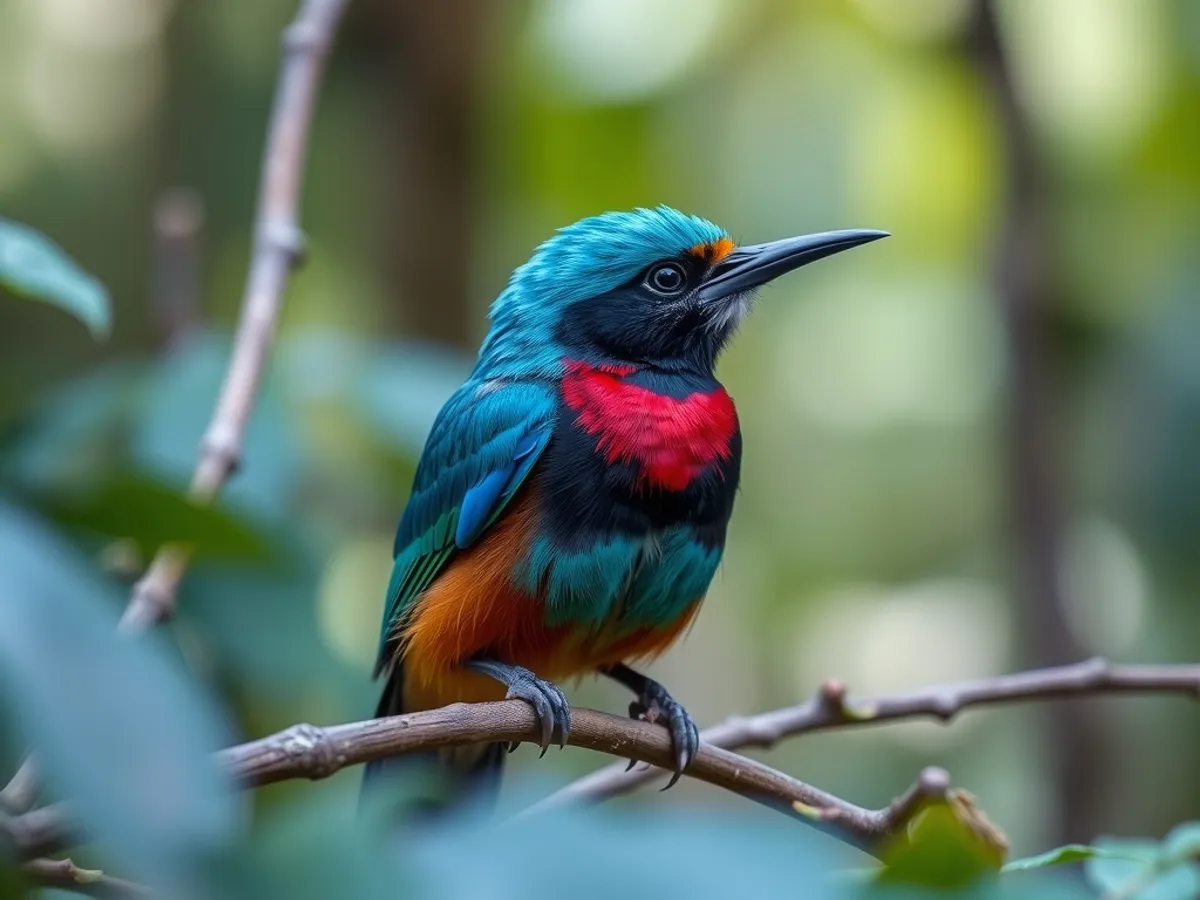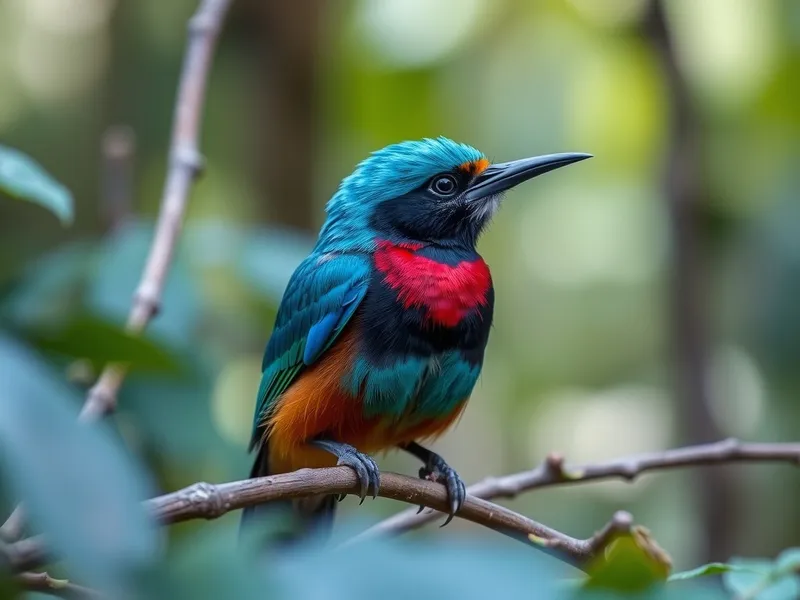
Blue-crowned Motmot
Momotus momota

Meet the Blue-crowned Motmot
The Blue-crowned Motmot is a striking bird known for its vibrant blue and green plumage and distinctive racket-tipped tail feathers. Native to the forests and woodlands of Central and South America, this species is often found perched quietly in the understory, blending into its lush surroundings. It feeds on a varied diet that includes insects, small reptiles, and fruits, making it an important part of its ecosystem. The motmot's unique call, resembling an owl's hoot, helps it communicate through dense vegetation.
Classification
Bird
Habitat
Tropical and subtropical forests
Diet
Omnivore
Lifespan
12-14 years
Conservation
Least Concern
Weight
90-140 grams
📖Fascinating Facts
Vivid Colors
Their plumage features a blend of rich blues, greens, and chestnut tones, making them one of the most colorful birds in their range.
Unique Nesting
Blue-crowned Motmots excavate horizontal burrows in earth banks where they lay their eggs, providing protection from predators.
Distinctive Call
Their call is a low, double-hooting sound that is often mistaken for an owl, especially deep in the forest.
📋Detailed Description
The Blue-crowned Motmot (Momotus momota) is a medium-sized bird, typically measuring 38–48 cm (15–19 in) in length, including its distinctive racket-tipped tail feathers, and weighing between 90–140 grams. Its plumage is a striking combination of emerald green on the back and wings, a vibrant turquoise-blue crown bordered by a black mask, and a cinnamon or rufous breast and belly. The most notable feature is its long tail, which ends in bare-shafted 'rackets' formed by the loss of barbs along the central feathers—a trait thought to play a role in social signaling. The bill is strong and slightly decurved, adapted for a varied omnivorous diet. Blue-crowned Motmots are typically solitary or found in pairs, often perching quietly in the shaded understory or mid-levels of humid lowland and foothill forests, forest edges, and secondary growth. Their cryptic behavior and stillness make them difficult to spot despite their vivid colors. They are known for their unique 'hoot' or 'whoop' calls, which carry over long distances and are used for territory defense and mate attraction. The species is non-migratory, maintaining year-round territories. Their eyes are large, aiding in low-light foraging at dawn and dusk. Motmots are cavity nesters, excavating long tunnels in earth banks for breeding. Their ecological role includes seed dispersal and insect population control, making them important contributors to forest health.
💡 Did you know?
Despite their bright colors, Blue-crowned Motmots are surprisingly hard to spot in the wild due to their stillness and preference for dense foliage.
🔬Research & Sources
Wikipedia Summary
The blue-capped motmot or blue-crowned motmot, is a colorful near-passerine bird found in forests and woodlands of eastern Mexico. This species and the Lesson's Motmot, Whooping Motmot, Trinidad Motmot, Amazonian Motmot, and Andean Motmot were all considered conspecific. The IUCN uses blue-crowned as their identifier for this species; however, it was also the name used for the prior species complex.
Last Modified: 3/20/2025
🎭Behavior & Social Structure
Blue-crowned Motmots are primarily crepuscular, being most active during early morning and late afternoon. They employ a sit-and-wait hunting strategy, perching motionless before swooping down to capture prey such as insects, spiders, small reptiles, and occasionally small mammals. Their diet is supplemented with fruits and berries, especially during the non-breeding season. Motmots often manipulate prey by beating it against a perch to subdue it or remove inedible parts. Socially, they are usually observed alone or in monogamous pairs, rarely forming larger groups except at abundant food sources. They are territorial, using vocalizations and tail displays to communicate with neighbors and potential mates. Tail wagging, especially the pendulum-like swinging of the racket-tipped tail, is a characteristic behavior thought to signal alertness or deter predators. They spend much of the day perched in dense foliage, emerging to forage or defend territory.
👶Reproduction & Life Cycle
Breeding occurs during the rainy season, typically from March to July, varying by region. Blue-crowned Motmots are monogamous, forming long-term pair bonds. Both sexes participate in excavating a horizontal nesting tunnel, often 1–2 meters long, in a vertical earth bank or sometimes in arboreal termite nests. The female lays 3–5 white, spherical eggs. Incubation lasts about 20 days and is shared by both parents. After hatching, both parents feed the altricial chicks, which fledge after approximately 28–30 days. Parental care continues for several weeks post-fledging. Nest predation by snakes, mammals, and other birds is a significant cause of reproductive failure.
🛡️Adaptations & Survival
The Blue-crowned Motmot's cryptic behavior and coloration provide camouflage in dappled forest light, reducing predation risk. Its strong, decurved bill allows it to handle a wide variety of prey and fruits, supporting dietary flexibility. The unique racket-tipped tail feathers are an evolutionary specialization, likely used in courtship and territorial displays—studies suggest tail movement may signal vigilance to predators. Their large eyes enhance visual acuity in low-light conditions, aiding crepuscular foraging. The ability to excavate nesting tunnels in earth banks is a behavioral adaptation that reduces nest predation and competition for nesting sites.
📚Research Sources
🎨Cultural Significance
Motmots have held symbolic significance in various indigenous cultures of Central and South America, often associated with beauty, mystery, and the forest spirit world. Their striking appearance and elusive behavior have inspired local myths, such as tales explaining their unique tail shape. In some regions, motmots are featured in folklore as guardians of the forest or as omens. They are occasionally depicted in traditional art and handicrafts, and their calls are recognized and imitated in local music. There is no widespread evidence of direct exploitation, but their presence is valued by ecotourism and birdwatching communities.
🔬Recent Research & Discoveries
Recent genetic and vocalization studies have clarified the taxonomy of the Momotus genus, leading to the split of what was once considered a single widespread species into several distinct species, including Momotus momota. Ongoing research focuses on the function of the racket-tipped tail, with evidence suggesting it plays a role in both sexual selection and predator deterrence. Studies on motmot vocalizations have revealed complex call repertoires used for territory defense and mate attraction. Ecological research highlights their role in seed dispersal and insect population regulation. Long-term monitoring is ongoing to assess the impacts of habitat fragmentation and climate change on population dynamics.
🎥Wildlife Videos

Wildlife Stories: Love is in the Wild | SPECIAL | Free Documentary Nature
Wildlife Stories: Love is in the Wild | Special | Free Documentary Nature Watch 'Wildlife Stories: Talking to Survive' here: ...
Free Documentary - Nature

Magic of the Moors - A Mysterious World Full of Life | Free Documentary Nature
Magic of the Moors - A Mysterious World Full of Life | Wildlife Documentary Watch 'Wild Germany: The Mecklenburg Lake Plateau' ...
Free Documentary - Nature

Wild France - A Spectacular Journey | Part 1 | Free Documentary Nature
Wild France - A Spectacular Journey: Part 1 | Wildlife Documentary Watch 'Wild France - Part 2' here: ...
Free Documentary - Nature

WILD AUSTRALIA | The Continent of the Strangest Predators #naturedocumentaries | Wild Nature
WILD AUSTRALIA | The Continent of the Strangest Predators #naturedocumentaries Welcome to an epic adventure through ...
WILD NATURE - Nature animal documentary

David Attenborough presents: Wild City Singapore | Full Series | Free Documentary Nature
David Attenborough presents: Wild City Singapore - Full Series | Wildlife Documentary Watch 'David Attenborough Presents: ...
Free Documentary - Nature

Blue-Crowned Motmot spotted in Soberania National Park of Panama
We buy and sell videos! Like us on facebook.com/the4kguy Blue-Crowned Motmot or Blue-Capped Motmot (Momotus ...
The 4K Guy - Nature & Urban
🌍Habitat Information
The Blue-crowned Motmot typically inhabits Tropical and subtropical forests environments. Blue-crowned Motmots have adapted to their environments with specialized features and behaviors.
Primary Habitat:
Tropical and subtropical forests
More detailed habitat information will be available soon.
🛡️Conservation Status
The Blue-crowned Motmot is currently classified as Least Concern. Conservation efforts are crucial for preserving this species for future generations.
Common Threats:
- 🏠Habitat loss and fragmentation
- 🌡️Climate change impacts
- 🎯Hunting and poaching
- 🏭Human-wildlife conflict
⚠️Threats & Conservation Challenges
Currently classified as Least Concern by the IUCN, the Blue-crowned Motmot faces localized threats from habitat loss due to deforestation, agricultural expansion, and urbanization. Fragmentation of forests can isolate populations and reduce suitable nesting sites. In some areas, nest predation and disturbance by humans or domestic animals are significant challenges. Despite these threats, the species remains widespread and adaptable, with stable populations in many regions. However, ongoing habitat degradation could pose future risks, particularly in areas with high rates of land conversion.
🔬Scientific Classification
Scientific Name
Momotus momota
Classification Hierarchy
🔍 About Taxonomic Classification
Taxonomic classification is a hierarchical system used by scientists to classify and organize living organisms based on shared characteristics and evolutionary relationships.
The system moves from broad categories (Kingdom) to increasingly specific ones, with each animal's scientific name typically consisting of its Genus and species.
📝Community Notes
Share your observations and insights about the Blue-crowned Motmot with our community of wildlife enthusiasts.
Join Our Community
Sign in to share your observations and connect with fellow wildlife enthusiasts.
Sign In to ContributeNo community notes yet
Be the first to share your observations about the Blue-crowned Motmot!
Explore Blue-crowned Motmot
Select a tab above to learn more about this amazing animal.
📸Photo Gallery
No photos available for this animal yet.
🌟Discover More Wildlife
Continue your journey of discovery with more fascinating animals from our database
